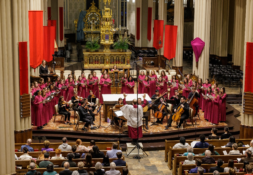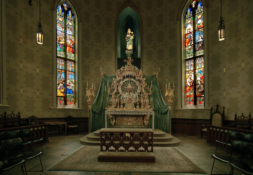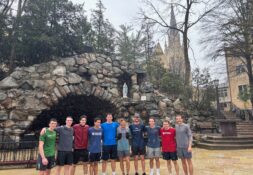Last week, I sat down with professor of architecture Thomas Gordon Smith to discuss his contribution to the new Alliance for Catholic Education (ACE) office under construction. We met in his office on the third floor of Bond Hall, a room that is more of a patchwork museum of antique, American furniture than a utilitarian faculty workspace. After he graciously offered me the only chair in the room that was made after MCMLXXIV, we jumped into the ACE project.
MB: First of all, how did you become involved with the design of the ACE building, and what exactly was your role in the project?
TGS: The university architect’s office had already contracted CSO Architects of Indianapolis to serve as the architect of record. CSO was also recently involved with the construction of Geddes Hall, and for the ACE building they handled the interior design and construction management. Out of concern for sensitivity to the older buildings in the vicinity, I was asked to design the exterior of the building.
MB: What was the project scope that your exterior had to accommodate?
TGS: The project initially consisted of two parts, the remodeling of the original chapel portion and the replacement for a preexisting addition to the north. The university had studied beforehand to determine if the former addition was itself significant, but concluded that it was basically a utilitarian box, and not particularly well-built at that, so it was torn down. Later on, Fr. Scully of ACE recognized the development potential of a high-profile project in attracting support. At that point, the building program was expanded to provide for future growth, and the tower at the northern end was the result.
MB: In working with CSO and the university architect, would you say there was a learning curve, and were they receptive to incorporating a classical exterior?
TGS: I think that ‘learning curve’ is certainly a term that they would agree with, and by the way, they were delightful to work with. In fact, the principal from CSO on this project, Dan Moriarity, is a Notre Dame grad. When we visited the site early in the project, he was the one who first suggested building the entry projection out into the parking lot. Originally it was going to be a single story, but later I decided to extend the second floor out over it for the conference room.
MB: So that is the space with the Serliana [an arched window with sidelights]?
TGS: Yes, it’s going to be a wonderful room in the new building. I think Fr. Scully is going to try to move into it permanently. Another space in the new building is the former chapel in the historic part. It retains its low wooden arches, and will be similar to the large study room on the first floor of Coleman-Morse when it opens.
MB: What were your goals in the iconographic scheme? How does it relate the mission of ACE?
TGS: The ornament is concentrated on the broad metopes [panels], which will display a variety of details. One will be what I think is a very beautiful cartouche for the CSC (Congregation of Holy Cross) from the cornerstone of Bond. There will also be a motto from Fr. Sorin which complements the ACE program. Overall, it’s a building with a very strong, identifiable presence. Stripped down, not a lot of detail (although it’s by no means a cheap building!). I think the sparingness is an appropriate quality; Catholic education right now is David in a very Goliath atmosphere. Some 15,000 parochial schools have closed in this country from their peak.
MS: What other important design cues or precedents did you use?
TGS: I’m particularly proud of the use of the mansard roof; it is so critical to successfully integrating the building with the nearby structures. I was also extremely pleased that we are using Indiana limestone for the columns at the entrance. The first shop drawings for cast stone ones came back with “bubble-gum” [caulked] joints running down the sides, and everyone agreed that wasn’t acceptable, so I’m pleased the university is taking seriously the importance of quality materials. I’m very happy about the use of the four brick pilasters. They were inspired by Borromini’s work for Vergilio Spada and the Oratorians in Piazza dell’Orologio [in Rome]. The building has a good, solid, Italian feeling to it, including the warm colored brick that bridges between the older neighbors and Lewis Hall.
MB: I understand you had quite a time finding a suitable brick…
TGS: Yes, as a result of the university’s pursuit of LEED certification, we had to source the bricks from within a certain radius of campus. John Haig, from my office, spent days scouring the area for a supplier who could meet our requirements. The color choice was also a factor. We finally found a company in Ohio that could do the job.
I hope these excerpts from our discussion have helped to give you a broader, multidimensional appraisal of the issues and aspirations involved in architectural undertakings like the ACE building. Next time, I introduce a new architecture student organization starting up on campus.
Matthew Balkey is a 4th year architecture major. In his “free time” he writes viewpoint letters about giraffes in refrigerators. His email is mbalkey@nd.edu.





